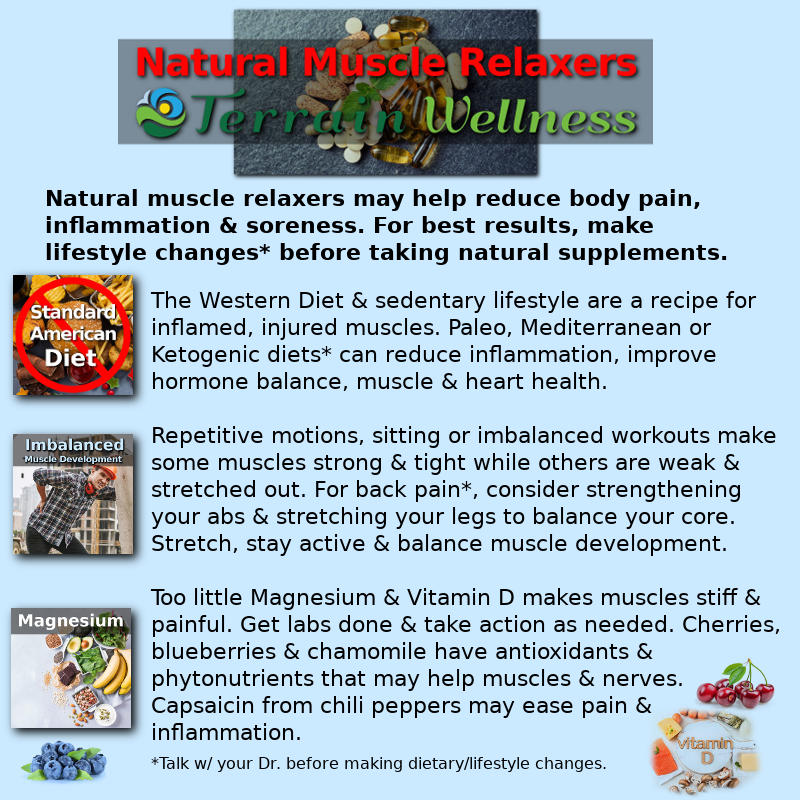Natural Muscle Relaxers
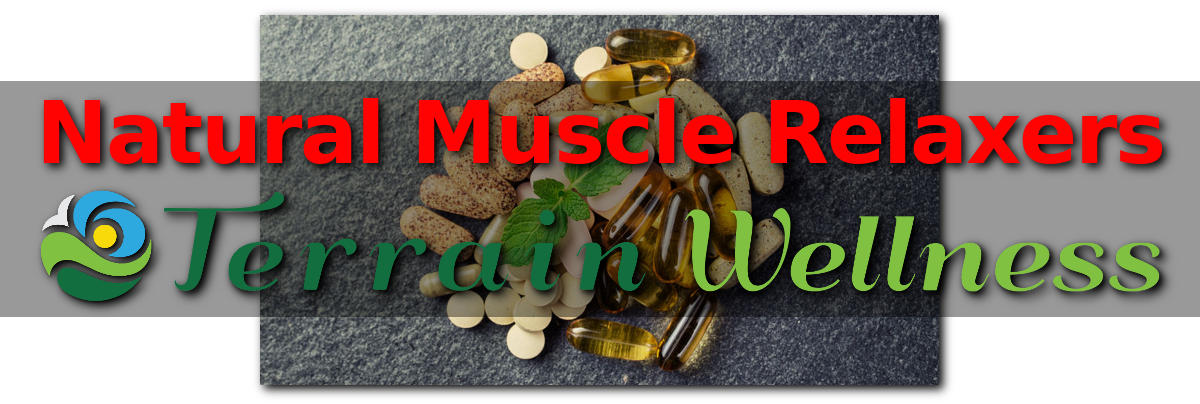
-
Contents:
- Introduction
- Injuries
- Pharmaceuticals
- Lifestyle Modification
- Drop The Western Diet
- Choose Nourishing Foods
- Avoid Over-Training
- Muscle Imbalances
- Get Moving & Stretch
- Address Nutrient Deficiencies
- Blueberries & Cherries
- Chamomile
- Hot Peppers, Capsaicin
- Vitamin D, Magnesium
- Conclusions
Many people experience muscle tightness, pain and discomfort at least some of the time. Natural muscle relaxers generally work by reducing inflammation and/or addressing nutritional deficiencies that affect our physiology. Muscle soreness and tightness may be due to repeated stress injury or strain from sitting or standing for prolonged periods. Muscle tightness can also be caused by repeated movements at work or specific exercises that need to be balanced out by opposing motions. For others, muscle tightness and soreness is related to poor food choices combined with a sedentary lifestyle. Before mentioning specific natural remedies or supplements, this discussion of natural muscle relaxers begins with fundamentals like food choices and lifestyle. This is because supplements and prescription medications usually won’t offer a permanent solution unless we take the extra time to create a healthy foundation around food and lifestyle first.
Beyond physical activity or inactivity, the foods we eat and the levels of various nutrients in the body also have a tremendous influence the experience of muscle or body pain. Some foods have beneficial properties while others are associated with things like inflammation, nutrient depletion and hormone imbalances. The Western Diet has long been associated with inflammation, autoimmune processes and is lacking in key nutrients necessary for proper muscle function. If we want our muscles to be strong, healthy and pain-free, we need to nourish them through sustainable food choices. Dietary considerations have a huge impact on how we feel in our bodies.
As a rule, I dislike the idea of “super-foods” because health is built through the totality of one’s food and lifestyle choices. Kale smoothies and secret Himalayan Berries won’t cancel out habitually poor eating fundamentals. Along this same line of reasoning, you might not get much benefit from a dietary supplement unless you’re already making healthy food choices and staying active. -Dr. Danielle Lockwood
Injuries & Muscle Tension
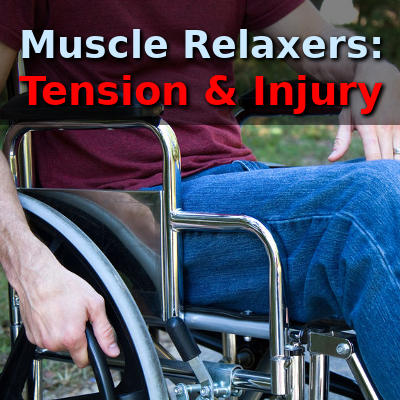
Please note, there are a number of injuries and health conditions that can result in muscle tightness and pain. These injuries may include car accidents, sports injuries and even brain/nerve damage. In cases of injuries to the nervous system, the brain may be sending signals to activate muscles at the wrong time or intensity, resulting in painfully cramped muscles that lose their proper range of motion over time. These severe cases of muscle pain and tightness may necessitate prescription medications, extensive physical therapy and even corrective surgery. Even in these extreme scenarios, proper nutrition and the totality of one’s health and wellness still influence recovery. That said, outside of a serious medical condition or injury, there are a number of factors that are within most people’s control that can help alleviate muscle pain and weakness while improving strength, quality of life and mobility.
Rather than thinking of natural remedies as a medication to take that solves a problem, taking a holistic perspective on the totality of one’s health is much more constructive. Dietary supplements can fill in the gaps in areas where you might need a little help, but they won’t make up for bad health fundamentals. Many of the dietary supplements we’ll discuss are foods (sometimes concentrated) that have beneficial health properties. In addition to dietary consideration, there are also lifestyle modifications that can also go a long way in alleviating muscle soreness and tightness.
What’s Wrong With Pharmaceutical Muscle Relaxers?

While there are over-the-counter pain relievers as well as prescription muscle relaxers available, these medications come with significant side effects that must be considered. As discussed elsewhere on our site, the side effects of Ibuprofen include kidney and liver damage, cartilage degeneration, stroke and heart attack. Prescription muscle relaxers like the commonly used drug Tizanidine also have serious side effects to consider such as dizziness, weakness, anxiety, blurred vision, flu-like symptoms, trouble speaking, uncontrolled muscle movements, vomiting, constipation, problems urinating, sore throat and abnormal liver tests. While there are certain conditions and situations where a prescription could be necessary, my goal for treatment is that my patients reach a level of wellness where medications are not necessary.
Given the serious side effects of both over-the-counter and prescription medications, natural alternatives might be worth considering for some people. Of course, talk with your doctor before taking supplements or medications. These natural muscle relaxers are at least worth a conversation.
- Drop the “Western Diet”
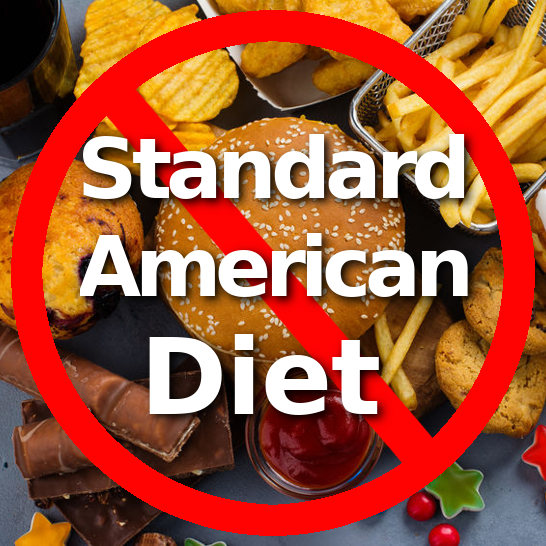 The “Western Diet”, also called the Standard American Diet, is strongly linked to inflammation, weight gain, diabetes, heart disease, hormone imbalance and cancer. When it comes to naturally relieving muscle tension and pain, we need to reduce inflammation and shed pounds that add more strain to our muscles and frame. The refined sugars, excess carbs and lack of nutrients that define many of the Western Diet’s staple foods feed unhealthy gut bacteria and cause harmful blood-sugar spikes (see: Thyroid and Blood Sugar). The inflammation and unhealthy gut bacteria associated with the Standard American Diet make it so that muscles can’t function properly and don’t get the nourishment they need.
The “Western Diet”, also called the Standard American Diet, is strongly linked to inflammation, weight gain, diabetes, heart disease, hormone imbalance and cancer. When it comes to naturally relieving muscle tension and pain, we need to reduce inflammation and shed pounds that add more strain to our muscles and frame. The refined sugars, excess carbs and lack of nutrients that define many of the Western Diet’s staple foods feed unhealthy gut bacteria and cause harmful blood-sugar spikes (see: Thyroid and Blood Sugar). The inflammation and unhealthy gut bacteria associated with the Standard American Diet make it so that muscles can’t function properly and don’t get the nourishment they need.
At the risk of oversimplification, the refined carbs and sugar common to processed foods feed bacteria and candida yeasts that can overgrow inside your intestines, resulting in inflammation and disease processes throughout the body. This bacterial and yeast overgrowth is tied to autoimmune processes, according to the research.
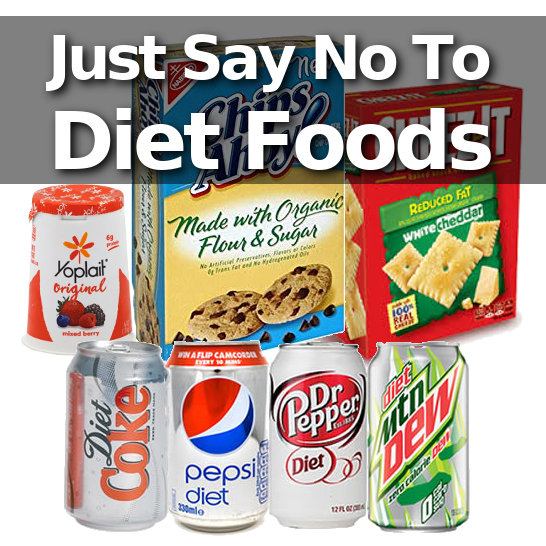
Sadly, the Western Diet also encompasses many foods that are marketed as “Diet”, “Organic” or “Reduced Fat”, which misleads consumers. Many diet/organic/reduced-fat options give people the false impression that these options are a healthier choice. However, there are no good short-cuts in life because organic junk food is still junk food. Organic sugar is still sugar, “fat free” options often still have a boatload of processed carbs. “Evaporated cane juice” is just a misleading name for sugar(see: NPR, Sugar In Disguise). Diet sodas and other foods/beverages containing sugar substitutes taste sweet because they fool the body into thinking you actually ate sugar. The catch is that the body responds with the same harmful insulin spike as if real sugar was eaten, when it actually wasn’t. This makes the blood-sugar crash that comes after eating artificial sugar substitutes even worse than what happens when real sugar is eaten. See: Diet Soda is Bad News for details.
- Choose Nourishing Foods
-
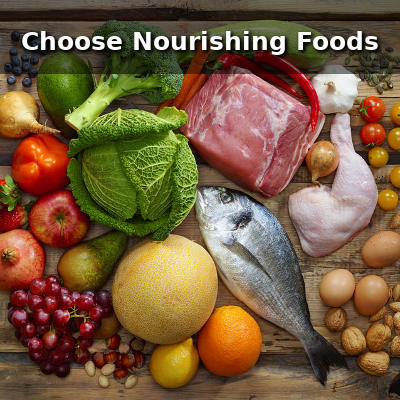
The one thing that will have the biggest impact on one’s overall health and wellness is the quality and quantity of the foods we eat. Food is deeply ingrained in our cultures, families, self-comforting and even our personal identities. For thousands of years, humans lived in environments where there was generally a very limited food supply. Sweet treats, fatty meats, shelter, warmth and safety were all exceedingly rare commodities for most of human history; we are the ancestors of that harsh background. To survive in that environment, people needed to eat as much food as they could when it was available in order to survive. Food not eaten immediately would spoil, or worse, attract hungry predators. Feasting during rare times of plenty was necessary for survival in years past. As such, it’s no surprise that eating food, especially sweets, fat and salty flavors, releases hormones into the body that make us feel good. In fact, the research shows that eating “highly palatable food” gives the brain a chemical reward by activating endorphins and opiate-receptor sites in the brain. Tasty food can be addicting.The problem is that today we have supermarkets in every neighborhood that are constantly jam-packed with every sweet, salty or savory snack you could ever want. We have technology, advanced culture and access to the world’s knowledge at our fingertips. But, deep down there’s a part of us all that’s still a barely house-broken hunter-gatherer with an Amazon Prime account. Many of today’s common preventable diseases like heart disease, hormone imbalance, type II diabetes and obesity used to only afflict the wealthiest of rulers because food was more scarce.
The above notwithstanding, we humans are also creatures of habit and we can use that to our advantage. On the bright side, physical activity and feeling healthy also release endorphins, feel-good chemicals in the brain. So it is possible to replace our unhealthy habits with ones that feel good and are good for us. Let’s use the abundance that we have in modern society to create what we want for our lives. We can achieve this through sustainable meal planning around three primary goals:
- Smooth Out Blood Sugar Peaks & Crashes
- Lower Inflammation
- Improve Gut Health
We can accomplish the above by choosing low Insulin Index foods while avoiding high inflammatory foods. The insulin index is a measurement of how much insulin the body releases after you eat a food. Predictably, sugary processed foods that are high in carbs have a high Insulin Index. Processed foods and high carb foods feed unhealthy gut bacteria and yeasts that cause inflammation. In contrast, low Insulin Index foods reduce inflammation and help create a much more balanced gut microbiome that can better digest and help the body absorb vitamins and minerals. In summary, eat more non-starchy vegetables and be sure to get enough protein.
-
Incorporate these foods:
- fish
- chicken
- turkey
- whole eggs
- avocado
- nuts
- olive oil
- spinach
- kale
- broccoli
- strawberries
- blueberries
- cherries
- orange
-
Limit or eliminate these foods:
- processed foods
- refined carbohydrates
- grains, bread, gluten
- zero calorie sugar substitutes
- french fries
- chips
- soda
- corn syrup
- sweetened yogurt
- candy
- desserts
For those looking for a more comprehensive meal-plan to try, many people have had success with various forms of the Mediterranean, Paleo and Ketogenic styles of eating. That said, I don’t like to make blanket recommendations for a one-size-fits-all meal plan. The main drawback to Paleo, Keto and Mediterranean “diets” is the diet part. “Diet” implies a temporary fix, whereas lasting results come from balanced food choices over the course of one’s entire lifetime.
- Avoid Over-Training
-
 Despite what many might tell you, muscle soreness after strenuous exercise is still not completely understood by science. According to the research, ideas about the physiology behind Delayed Onset Muscle Soreness or DOMS for short, are not known, but researchers suspect muscle inflammation due to damage is involved (See: PubMed, DOMS). Some stiffness or soreness is normal after a particularly strenuous exercise. But, there’s a fine line between a little bit of normal DOMS and a damaging muscle strain or sprain that requires considerable time to heal. Stiff painful muscles might be your body’s way of communicating that it needs time to rest and recover. Or, it may be a sign that the body needs to be replenished, because physical exertion comes with high caloric and nutritional demands.
Despite what many might tell you, muscle soreness after strenuous exercise is still not completely understood by science. According to the research, ideas about the physiology behind Delayed Onset Muscle Soreness or DOMS for short, are not known, but researchers suspect muscle inflammation due to damage is involved (See: PubMed, DOMS). Some stiffness or soreness is normal after a particularly strenuous exercise. But, there’s a fine line between a little bit of normal DOMS and a damaging muscle strain or sprain that requires considerable time to heal. Stiff painful muscles might be your body’s way of communicating that it needs time to rest and recover. Or, it may be a sign that the body needs to be replenished, because physical exertion comes with high caloric and nutritional demands.
Over-training due to excess exertion, too little recovery time or both can result in weakened muscles that are stiff and painful. Not only that, but over-training can tax your body’s nutrients faster than your diet can replace them. The bottom line is that avoiding over-training is a great natural way to avoid excessive muscle tension. If you have exceptionally sore muscles, your body may be telling you that it needs more time to recover. In these instances, reaching for a pain reliever or a muscle relaxer might be the wrong move, because what you really need is rest and recovery.
- Address Muscle Imbalances
-
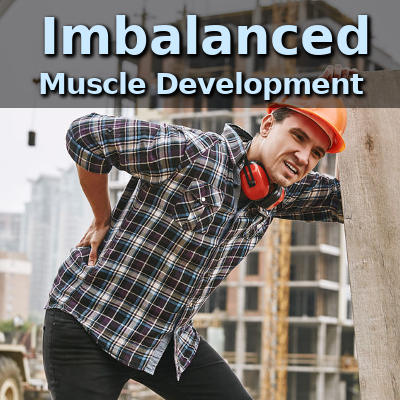
Certain exercises and occupations develop/stengthen specific muscles. If care is not taken to do complimentary exercises of opposing muscle groups and stabilizing muscles, imbalances can occur. An example of this may be someone whose occupation requires repeated heavy lifting and stacking throughout the day. Over time, this person’s legs, back, arms and shoulders would gain strength commensurate with the activity. However, their abdominal muscles might not get as much development, leaving them loose and underdeveloped in comparison to the back. This imbalance between abdominal muscles and back muscles can lead to low back pain, tight back muscles, problems with posture and put one at risk for back injury. Another example might be an athlete who focused on a gym exercise like bench press while giving little attention to the opposing muscle exercises such as rows that develop the muscles of the back and shoulder blades. When this athlete’s chest muscles get much stronger from repeated bench press while their back muscles do not, their shoulders can be pulled into a painful misalignment.Muscle imbalances can also occur from sedentary activities like sitting at a desk, driving a car or resting. Sitting relaxes some muscles and tendons while stretching others in unnatural ways that can create tight, injury-prone muscles over time. Repetitive motions, imbalanced workouts and long periods of inactivity can all contribute to muscle imbalances that set the stage for tight, injured muscles. The best cure for muscles that tighten up during long periods of inactivity is to break up periods of inactivity by standing up, walking around, stretching or incorporating exercise throughout the day. To learn about these issues in greater detail, see: 6 Things to Know About Muscle Imbalances.
In summary, it’s important to balance our muscle development to avoid injuries caused by joints misaligned by uneven forces. Following this rule may reduce the chance of injury and mitigate the need for muscle relaxers.
- Get Moving & Stretch
-

Now that we’ve covered the fact that over-training can result in stiff muscles, we need to look at the other side of the equation. A sedentary lifestyle defined by long periods of sitting and a lack of physical activity also results in muscle tightness, pain and loss of strength. The untrained muscles that cannot adequately support the body cause muscles that are too loose or too tight as the body compensates for long periods of inactivity. Tight, sore back and neck muscles coincide with loose, unsupportive abdominal muscles that cause the painfully poor posture common with inactive people. Other consequences of inactivity include slowed metabolism and a general decline in health that puts increased strain on muscles already weakened by inactivity.Beyond muscles, poor blood circulation, depressed mood, increased inflammation and hormonal imbalance also accompany a lack of exercise (See: MedLinePlus.gov). Taken together, habitual inactivity can cause muscle tightness in some areas and loose unsupportive muscles in others. The results of this pattern are inflammation, pain and increased chances of muscle or joint injury. I could go on, but by now it should be abundantly clear that we as a society need to get moving. Movement can take the form of stretching, yoga, taking breaks from sitting at a desk where you get up and do a few simple exercises/stretches. Physical activity should be a part of everyone’s day.
When we do exercises like lifting weights or running, it’s important to realize that these activities are mainly about our muscles contracting forcefully in order to propel us forward or lift a weight. The problem with this is that we often focus a lot on exercises improve the force/endurance of our muscle contractions while giving much less attention to stretching. A comprehensive stretching routine should be part of everyone’s exercise routine.
For these reasons and more, moderate physical activity balanced with stretching on a regular basis is a great natural muscle relaxer.
- Resolve Nutrient Deficiencies
-
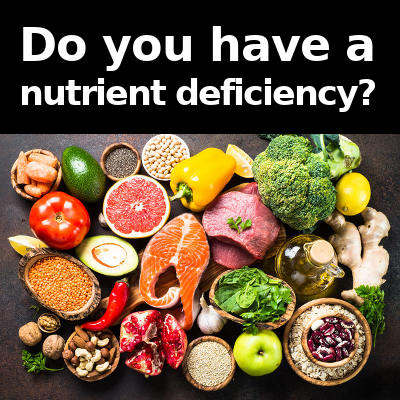
The next topic related to muscle tightness, pain or inflammation is to examine the foods we eat. Certain nutrient deficiencies, such as too little Vitamin D, have been associated with deep muscle pain, according to the research. Other nutrient deficiencies like a lack of complete proteins and B Vitamins can result in muscle pain and weakness. Harvard Researchers found that a lack of B Vitamins associated with vegetarian diets and weight-loss surgery may result in muscle weakness, fatigue and brain fog in individuals who did not adequately supplement their diet. Adequate protein intake is vital to healthy muscles.It’s important to use caution when taking vitamins and supplements because it’s possible to take too much of some vitamins and minerals. For this reason, we do comprehensive labs on our patients so that we can prescribe what’s missing. Talk with your doctor before taking vitamins and supplements.
Lifestyle Modifications to Reduce Muscle Tension
Before taking supplements or eating “super-foods” as a natural muscle relaxer, make sure that you have these fundamentals in place beforehand. Dietary supplements are not a band-aid and they won’t make up for poor food choices and a sedentary lifestyle, so these lifestyle and dietary changes are the first step.
A supplement will only help insofar as it optimizes our body’s internal chemistry. If you already have the right amount of a vitamin, taking more probably wouldn’t help you. In fact, too much of some vitamins and minerals can be harmful. That said, even those who eat healthy may lack a few nutrients. As a rule, I dislike the idea of “super-foods” because health is built through the totality of one’s food and lifestyle choices. Kale smoothies and secret Himalayan Berries won’t cancel out habitually poor eating fundamentals. Along this same line of reasoning, you might not get much benefit from a dietary supplement unless you’re already making healthy food choices and staying active.
With that out of the way, it’s time to examine some specific vitamins, minerals and foods that can act as natural muscle relaxers:
- Cherries and Blueberries
-

Cherries are rich in antioxidants, vitamin C, Potassium and the hormone precursor tryptophan. Tryptophan being a precursor to the sleep and mood regulating hormones melatonin and serotonin (See: PubMed Sweet & Tart Cherries). Most studies cited found that cherries made a difference in muscle recovery. Similarly, blueberries are loaded with antioxidants and anti-inflammatory polyphenols. In one small study, researchers concluded that blueberries might improve athletic performance while also lowering harmful inflammation (see: PubMed, Blueberries & Exercise). More research is needed on the effects of both blueberries and cherries. However, it seems clear that each of these foods has a number of health benefits when eaten along with low-inflammatory foods that you might find in Paleo or Mediterranean diets.
Of course, please use common sense and avoid sugary desserts that are often made with cherries or blueberries because the blood-sugar spike and inflammation that come with sugar and refined carbs would undo all of the benefits that these berries may give you. Sorry folks, cherry pie and blueberry cobbler won’t solve your muscle pain.Don’t expect miracles from eating cherries and blueberries, but do incorporate them into your meal plan because they are tasty and pack a lot of nutrition and health benefits. More research is needed, but these berries just might help muscles recover faster.
- Chamomile
-

Chamomile is an herbal remedy that has been used medicinally since ancient times. Chamomile is used as an essential oil, topically as an ointment or compress, but is by far most commonly used as an herbal tea. Chamomile is thought to have a number of beneficial properties like reducing pain/cramping, lowering blood-sugar, helping to promote healthy sleep and may help reduce cold symptoms. With regard to natural muscle relaxers, chamomile may help reduce muscle spasms and cramping, according to researchers. Interestingly, researchers find that chamomile also acts as an anti-inflammatory agent. By reducing inflammation, helping with muscle cramps and aiding in relaxation, chamomile is definitely worth considering as a natural muscle relaxer.Ask your doctor if chamomile is right for you.
- Hot Peppers
-
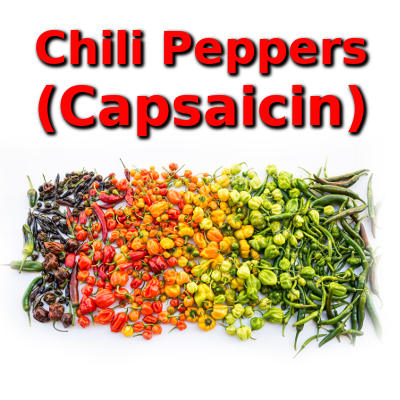
Capsaicin is a phytochemical found in spicy foods like Cayenne pepper, jalapeño peppers, habanero peppers and other chili peppers. Capsaicin works by interacting with sensory nerves and other tissues in the body, creating the sensation of heat or burning. But, the effects of these peppers goes well beyond simply creating that tingling burn that those who crave spicy foods have grown to love. Capsaicin produces profound effects in the body, the exact mechanism of these effects are still being researched. Research has shown that capsaicin may help lower cholesterol, help lower blood pressure, regulate appetite, help with weight loss, reduce inflammation and increase heart-health (see: PubMed Capsaicin). Researchers also note that capsaicin affects how the body interprets and sends pain signals and this process may play a role in how it may reduce inflammation (see: Treating Pain with Capsaicin).In the short-term, capsaicin may cause irritation and/or burning or tingling. Also, over-using capsaicin-containing products (or just eating too many hot peppers) may cause upset stomach and other unpleasant GI symptoms. Capsaicin isn’t right for everyone, so ask your doctor before using it. Capsaicin might aggravate certain digestive issues and it is not right for everyone. If you do try capsaicin ointments, test a small amount first to see how you react. Accidentally touching your eyes, face, nose or genitals after using capsaicin ointments may cause very uncomfortable irritation, so be sure to use it carefully. for this reason, be very careful to wash your hands after applying it and follow all product instructions.
All this notwithstanding, capsaicin remains a very popular ingredient for helping ease painful joints and muscles.
- Vitamin D & Magnesium
-

Vitamin D is important for proper muscle and metabolic function. Symptoms of Vitamin D deficiency include muscle pain, bone loss, depression, bone and back pain, slower wound healing, hair loss and fatigue. Although Vitamin D deficiency is serious and results in muscle pain and weakness, it is nonetheless common in America. Foods like egg yolks, salmon and liver are naturally high in Vitamin D. The other way that the body gets Vitamin D is through our skin being exposed to sunlight. Strange as it may seem, cells in our skin create Vitamin D by converting cholesterol in a reaction involving UV light. Because the body producing its own Vitamin D is sunlight dependent, people living in cooler climates are more likely to be deficient, especially in the winter. About 15 minutes of sun exposure is enough to complete the process, so please be careful to limit your time in the sun.With Vitamin D, it’s important to also realize that it is possible to have too much of a good thing. Vitamin D is a fat-soluble vitamin, meaning that it gets stored in body-fat. As a fat-soluble vitamin, it is harder for the body to eliminate excess Vitamin D if it has too much on hand. In contrast, a healthy person would be much more able to eliminate excess amounts of a water-soluble vitamin, such as Vitamin C. Keep in mind, some Vitamin D supplements may contain over 1000% of one’s recommended daily allowance, so please talk with your doctor and strongly consider getting labs so you have the whole picture of your nutritional needs.

Magnesium is a very important mineral in the human body. In fact, there are over 300 biological processes that involve magnesium. Magnesium plays a role in nervous system and muscle function. As such, healthy magnesium levels is a prerequisite pain-free muscles that work properly. Symptoms of magnesium deficiency include cramps, tremors and twitching. Due to these symptoms, a magnesium deficiency might lead someone to think they need a muscle relaxer. Interestingly, consuming nourishing foods that are high in protein, calcium and Vitamin D cause the body’s demands for magnesium to increase.- Fruit: Bananas, Avocados & Apricot
- Nuts: Cashews, Almonds & Brazil Nuts
- Beans, Peas & Legumes
- Vegetables: Kale, Spinach, Collard Greens & Mustard Greens
- Meats: Salmon, Halibut, & Mackerel
- Dark Chocolate
High Magnesium Foods:
Please consider that magnesium can be dangerous for people with certain heart conditions, renal diseases like kidney failure, bowel obstructions and muscular disorders. On the other side, Celiac disease, Crohn’s disease, Type 2 Diabetes and chronic diarrhea can easily lead to magnesium depletion. With the above in mind, talk with your doctor before supplementing magnesium.
Natural Muscle Relaxers
Conclusions:
This discussion of natural muscle relaxers certainly covered a lot of ground. The reason for this is that discussing supplements, vitamins or even pharmaceutical muscle relaxers without addressing the underlying physiology may not produce lasting results. Inflammation due to the Western Diet combined with a sedentary lifestyle can cause a host of health problems, muscle pain being one. Additionally, repetitive activities at work or during exercise can create imbalanced muscle strength and weakness that can also result in painful muscles and injury-prone physical imbalances. While it’s fun to zoom in and take a close view of how a certain “super-food” or natural supplement might produce profound improvements in our health, looking at the totality of our health and fitness is usually more productive.
- Supplements, “super-foods” and fads, while beneficial, can never replace the need a well-rounded nutrition plan.
- Aside from food choices, an active lifestyle including daily physical movement and stretching is a must if you want to be healthy. Exercise, do yoga, or just walk around and stretch. Just do something.
- Center your meal-plan around nourishing whole foods like non-processed meats and non-starchy vegetables.
- Avoid processed foods and excessive carbohydrates.
- Shun “diet foods” because these often have sugar substitutes and/or cleverly disguised sugar, both of which are tied to health problems.
- Organic junk food is still junk food
- Certain fruits and vegetables contain vitamins and minerals that are necessary for muscle health. Other foods have anti-inflammatory properties that also improve muscle function.
- Get labs done because tense, painful muscles can be a symptom of deficiencies of Vitamin D, magnesium or B vitamins. Be careful, too much of certain vitamins and minerals can be harmful.
Key Points:
I hope this article was helpful for you. Thanks for reading.
Yours in health,
Dr. Danielle Lockwood & the Terrain Wellness Team.

